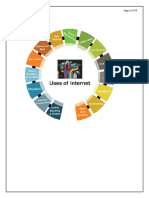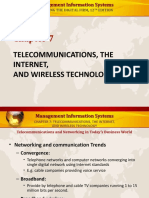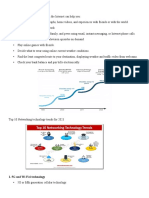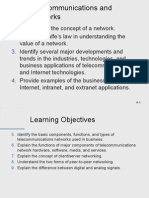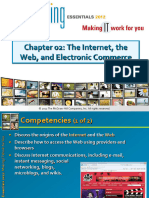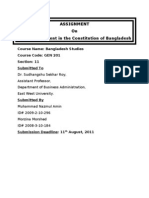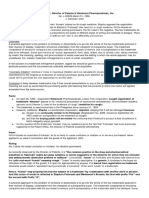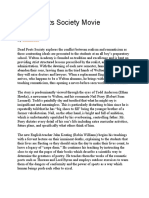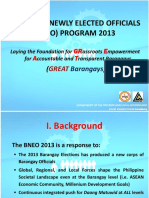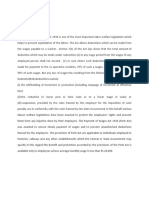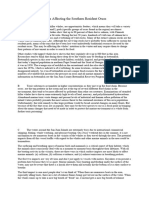Telecommunications, The Internet, and Wireless Technology
Telecommunications, The Internet, and Wireless Technology
Uploaded by
Xedap VNCopyright:
Available Formats
Telecommunications, The Internet, and Wireless Technology
Telecommunications, The Internet, and Wireless Technology
Uploaded by
Xedap VNOriginal Title
Copyright
Available Formats
Share this document
Did you find this document useful?
Is this content inappropriate?
Copyright:
Available Formats
Telecommunications, The Internet, and Wireless Technology
Telecommunications, The Internet, and Wireless Technology
Uploaded by
Xedap VNCopyright:
Available Formats
Chapter 7
Telecommunications, the Internet, and
Wireless Technology
Video cases:
Case 1: Telepresence Moves Out of the Boardrooom and Into the Field
Case 2: Unified Communications Systems: Virtual Collaboration with Lotus
Sametime
6.1 Copyright © 2014 Pearson Educationpublishing as Prentice Hall
Management Information Systems, Global Edition
Chapter 7: Telecommunications, the Internet, and Wireless Technology
Telecommunications and Networking in Today’s Business World
• Networking and Communication Trends
– Convergence:
• Telephone networks and computer networks converging
into single digital network using Internet standards
– Broadband:
• More than 68% U.S. Internet users have broadband
access
– Broadband wireless:
• Voice, data communication are increasingly taking place
over broadband wireless platforms
7.2 Copyright © 2014 Pearson Education
Management Information Systems, Global Edition
Chapter 7: Telecommunications, the Internet, and Wireless Technology
Telecommunications and Networking in Today’s Business World
• Computer network
– Two or more connected computers
– Major components in simple network
• Client and server computers
• Network interfaces (NICs)
• Connection medium
• Network operating system
• Hubs, switches, routers
– Software-defined networking (SDN)
• Functions of switches and routers managed by central program
7.3 Copyright © 2014 Pearson Education
Management Information Systems, Global Edition
Chapter 7: Telecommunications, the Internet, and Wireless Technology
Telecommunications and Networking in Today’s Business World
• Key digital networking technologies
– Client/server computing
• Distributed computing model
• Clients linked through network controlled by network
server computer
• Server sets rules of communication for network and
provides every client with an address so others can find
it on the network
• Has largely replaced centralized mainframe computing
• The Internet: largest implementation of client/server
computing
7.4 Copyright © 2014 Pearson Education
Management Information Systems, Global Edition
Chapter 7: Telecommunications, the Internet, and Wireless Technology
Communications Networks
• Signals: Digital versus analog
– Modem: translates digital signals into analog form (and
vica versa)
• Types of networks
– Local-area networks (LANs)
• Ethernet
• Client/server vs. peer-to-peer
– Wide-area networks (WANs)
– Metropolitan-area networks (MANs)
– Campus area networks (CANs)
7.5 Copyright © 2014 Pearson Education
Management Information Systems, Global Edition
Chapter 7: Telecommunications, the Internet, and Wireless Technology
Functions of the Modem
Figure 7-5 A modem is a device that translates digital signals into analog form (and vice versa) so that computers can
transmit data over analog networks such as telephone and cable networks.
7.6 Copyright © 2014 Pearson Education
Management Information Systems, Global Edition
Chapter 7: Telecommunications, the Internet, and Wireless Technology
The Global Internet
• What is the Internet?
• Internet addressing and architecture
– IP addresses
• The Domain name system (DNS)
– Converts IP addresses to domain names
– Hierarchical structure
– Top-level domains
• Internet architecture and governance
– No formal management: IAB, ICANN, W3C
– The future Internet: IPv6 and Internet2
7.7 Copyright © 2014 Pearson Education
Management Information Systems, Global Edition
Chapter 7: Telecommunications, the Internet, and Wireless Technology
The Domain Name System
The Domain Name System is a
hierarchical system with a root
domain, top-level domains,
second-level domains, and host
computers at the third level.
Figure 7-6
7.8 Copyright © 2014 Pearson Education
Management Information Systems, Global Edition
Chapter 7: Telecommunications, the Internet, and Wireless Technology
The Global Internet
• Internet services
– E-mail
– Chatting and instant messaging
– Electronic discussion groups / newsgroups
– Telnet
– File Transfer Protocol (FTP)
– World Wide Web
– VoIP
– Virtual private network (VPN)
7.9 Copyright © 2014 Pearson Education
Management Information Systems, Global Edition
Chapter 7: Telecommunications, the Internet, and Wireless Technology
The Global Internet
• The Web
– Hypertext Markup Language (HTML)
– Hypertext Transfer Protocol (HTTP):
• Communications standard used for transferring Web
pages
– Uniform resource locators (URLs):
• Addresses of Web pages
– http://www.megacorp.com/content/features/082602.html
– Web servers
– Software for locating and managing Web pages
7.10 Copyright © 2014 Pearson Education
Management Information Systems, Global Edition
Chapter 7: Telecommunications, the Internet, and Wireless Technology
The Global Internet
• Search engines
– Started as simpler programs using keyword indexes
– Google improved indexing and created page ranking
system
• Mobile search: 20% of all searches in 2012
• Search engine marketing
– Major source of Internet advertising revenue
• Search engine optimization (SEO)
– Adjusting Web site and traffic to improve rankings in
search engine results
7.11 Copyright © 2014 Pearson Education
Management Information Systems, Global Edition
Chapter 7: Telecommunications, the Internet, and Wireless Technology
The Global Internet
• Social search
– Google +1, Facebook Like
• Semantic search
– Anticipating what users are looking for rather than
simply returning millions of links
• Intelligent agent shopping bots
– Use intelligent agent software for searching Internet
for shopping information
7.12 Copyright © 2014 Pearson Education
Management Information Systems, Global Edition
Chapter 7: Telecommunications, the Internet, and Wireless Technology
The Global Internet
• Web 2.0
– Second-generation services
– Enabling collaboration, sharing information, and
creating new services online
– Features
• Interactivity
• Real-time user control
• Social participation (sharing)
• User-generated content
7.13 Copyright © 2014 Pearson Education
Management Information Systems, Global Edition
Chapter 7: Telecommunications, the Internet, and Wireless Technology
The Global Internet
– Web 2.0 services and tools
• Blogs: chronological, informal Web sites created by
individuals
– RSS (Really Simple Syndication): syndicates Web content so
aggregator software can pull content for use in another setting
or viewing later
– Blogosphere
– Microblogging
• Wikis: collaborative Web sites where visitors can add,
delete, or modify content on the site
• Social networking sites: enable users to build
communities of friends and share information
7.14 Copyright © 2014 Pearson Education
Management Information Systems, Global Edition
Chapter 7: Telecommunications, the Internet, and Wireless Technology
The Global Internet
• Web 3.0: The “Semantic Web”
– A collaborative effort led by W3C to add layer of
meaning to the existing Web
– Goal is to reduce human effort in searching for and
processing information
– Making Web more “intelligent” and intuitive
– Increased communication and synchronization with
computing devices, communities
– “Web of things”
– Increased cloud computing, mobile computing
7.15 Copyright © 2014 Pearson Education
Management Information Systems, Global Edition
Chapter 7: Telecommunications, the Internet, and Wireless Technology
The Wireless Revolution
• Cellular systems
– Competing standards
• CDMA: United States only
• GSM: Rest of world, AT&T, T-Mobile
– Third-generation (3G) networks
• 144 Kbps
• Suitable for e-mail access, Web browsing
– Fourth-generation (4G) networks
• Up to 100 Mbps
• Suitable for Internet video
7.16 Copyright © 2014 Pearson Education
Management Information Systems, Global Edition
Chapter 7: Telecommunications, the Internet, and Wireless Technology
The Wireless Revolution
• Wireless computer networks and Internet
access
– Bluetooth (802.15)
• Links up to 8 devices in 10-m area using low-power, radio-based
communication
• Useful for personal networking (PANs)
– Wi-Fi (802.11)
• Set of standards: 802.11
• Used for wireless LAN and wireless Internet access
• Use access points: device with radio receiver/transmitter for
connecting wireless devices to a wired LAN
7.17 Copyright © 2014 Pearson Education
Management Information Systems, Global Edition
Chapter 7: Telecommunications, the Internet, and Wireless Technology
The Wireless Revolution
• Wireless computer networks and Internet
access
– Wi-Fi (cont.)
• Hotspots: one or more access points in public place to
provide maximum wireless coverage for a specific area
• Weak security features
– WiMax (802.16)
• Wireless access range of 31 miles
• Require WiMax antennas
7.18 Copyright © 2014 Pearson Education
Management Information Systems, Global Edition
Chapter 7: Telecommunications, the Internet, and Wireless Technology
The Wireless Revolution
• Radio frequency identification (RFID)
– RFID tags:
• Tiny tags with embedded microchips contain data about an item
and location
• Transmit radio signals over short distances to RFID readers
– RFID readers:
• Send data over network to computer for processing
– Active RFID:
• Tags have batteries
• Data can be rewritten
• Range is hundreds of feet
7.19 Copyright © 2014 Pearson Education
Management Information Systems, Global Edition
Chapter 7: Telecommunications, the Internet, and Wireless Technology
The Wireless Revolution
• RFID (cont.)
– Passive RFID:
• Range is shorter
• Smaller, less expensive
• Powered by radio frequency energy
– Common uses:
• Automated toll-collection
• Tracking goods in a supply chain
– Requires companies to have special hardware and
software
– Reduction in cost of tags making RFID viable for many
firms
7.20 Copyright © 2014 Pearson Education
You might also like
- Parental Divorce, Parent-Child Ties, and Health: Explaining Long-Term Age Differences in VulnerabilityDocument20 pagesParental Divorce, Parent-Child Ties, and Health: Explaining Long-Term Age Differences in VulnerabilityLaura CroitoruNo ratings yet
- Terrance Arbitration DemandDocument9 pagesTerrance Arbitration DemandTechCrunch100% (1)
- 11479134Document24 pages11479134Hamssa Hasrouny ChalfounNo ratings yet
- Management Information Systems: Managing The Digital Firm: Sixteenth Edition - Global EditionDocument48 pagesManagement Information Systems: Managing The Digital Firm: Sixteenth Edition - Global Editionsj50025010No ratings yet
- Telecommunications, The Internet, and Wireless TechnologyDocument24 pagesTelecommunications, The Internet, and Wireless Technology3345dNo ratings yet
- Telecommunications, The Internet, and Wireless TechnologyDocument46 pagesTelecommunications, The Internet, and Wireless TechnologyXxBlueZCyberHydroMagnumxXNo ratings yet
- Lecture 7 - Chapter 7Document41 pagesLecture 7 - Chapter 7Wei NingNo ratings yet
- Telecommunications, The Internet, and Wireless TechnologyDocument26 pagesTelecommunications, The Internet, and Wireless TechnologyAida NatashaNo ratings yet
- CHP6Document47 pagesCHP6Akmal AkramNo ratings yet
- MIS Week9 - Telecommunication. The Internet, and Wireless Technology - Jefri YushendriDocument25 pagesMIS Week9 - Telecommunication. The Internet, and Wireless Technology - Jefri YushendriNovicha SariNo ratings yet
- Managing Information Systems: Seventh Canadian EditionDocument32 pagesManaging Information Systems: Seventh Canadian EditionJayson KingNo ratings yet
- Management Information Systems: Managing The Digital Firm: Fifteenth EditionDocument48 pagesManagement Information Systems: Managing The Digital Firm: Fifteenth EditionLicia SalimNo ratings yet
- CH 04 1 - UnlockedDocument37 pagesCH 04 1 - UnlockedjzNo ratings yet
- Laudon - Mis16 - PPT - ch07 - KL - CE - Telecommunications, The Internet, and Wireless TechnologyDocument48 pagesLaudon - Mis16 - PPT - ch07 - KL - CE - Telecommunications, The Internet, and Wireless TechnologySandaru Rathnayake100% (2)
- Unit-I Introduction To NetworkingDocument22 pagesUnit-I Introduction To Networkingbgtcm.rushangNo ratings yet
- Group2 Written ReportDocument17 pagesGroup2 Written ReportJireh Raphael MoralesNo ratings yet
- Networking Discovery Amti5Document44 pagesNetworking Discovery Amti5Anil WeerasooriyaNo ratings yet
- Chap 2 E-Commerce Infrastructure 30 Nov 2019Document20 pagesChap 2 E-Commerce Infrastructure 30 Nov 2019KY10NANo ratings yet
- Chapter 7: Telecommunications, The Internet, and Wireless TechnologyDocument21 pagesChapter 7: Telecommunications, The Internet, and Wireless Technologyahnyoungs2No ratings yet
- Management Information Systems: Managing The Digital Firm: Telecommunications, The Internet, and Wireless TechnologyDocument54 pagesManagement Information Systems: Managing The Digital Firm: Telecommunications, The Internet, and Wireless TechnologyHammad HassanNo ratings yet
- Laudon Mis16 PPT Ch07 KL CE, Telecoms, Internet, Wireless TechDocument44 pagesLaudon Mis16 PPT Ch07 KL CE, Telecoms, Internet, Wireless Technajib.shamlan2020No ratings yet
- Paper 6: Management Information System Module 12: Internet, Intranet, Extranet, MIS & EnterpriseDocument15 pagesPaper 6: Management Information System Module 12: Internet, Intranet, Extranet, MIS & EnterpriseppghoshinNo ratings yet
- Bahan PPT 7Document48 pagesBahan PPT 7apip ajaNo ratings yet
- Internet. Social NetworksDocument22 pagesInternet. Social NetworksjuscatNo ratings yet
- Dcap408 Web ProgrammingDocument321 pagesDcap408 Web ProgrammingmartinNo ratings yet
- PPT07 Telecommunications, The Internet, and The Wireless TechnologyDocument57 pagesPPT07 Telecommunications, The Internet, and The Wireless TechnologyyarenNo ratings yet
- Introduction To The Internet and World Wide Web World Wide Web (In Chapter 1)Document7 pagesIntroduction To The Internet and World Wide Web World Wide Web (In Chapter 1)Crisjoan BautistaNo ratings yet
- Characterization of Distributed SystemsDocument20 pagesCharacterization of Distributed Systemsanish.t.pNo ratings yet
- Telecommication and NetworksDocument64 pagesTelecommication and NetworksAynalemNo ratings yet
- E-Commerce 2018: Business. Technology. Society: Fourteenth EditionDocument54 pagesE-Commerce 2018: Business. Technology. Society: Fourteenth EditionCarlo WidjajaNo ratings yet
- 4564-4392 Mis11e ch07Document8 pages4564-4392 Mis11e ch07Nitish GuptaNo ratings yet
- Web Technology HandoutDocument159 pagesWeb Technology HandoutTame PcAddictNo ratings yet
- 08 - Digital Networks and The Triple Bottom LineDocument33 pages08 - Digital Networks and The Triple Bottom LineewingsetyadiNo ratings yet
- Module 2 Lesson 2 Living in The IT EraDocument6 pagesModule 2 Lesson 2 Living in The IT EraCaleb Jedel OlivoNo ratings yet
- Internet and Its Applications New2023-24 FULLUNITSDocument77 pagesInternet and Its Applications New2023-24 FULLUNITSvalliyamai93No ratings yet
- 7 Net TelecomDocument82 pages7 Net TelecomzhaniyaNo ratings yet
- CH 7Document44 pagesCH 7Agnes AuroraNo ratings yet
- Enhance The Interaction Between Mobile Users and Web Services Using Cloud ComputingDocument9 pagesEnhance The Interaction Between Mobile Users and Web Services Using Cloud ComputingAmoxcilinNo ratings yet
- Computer NetworksDocument29 pagesComputer Networksnofiya yousufNo ratings yet
- Distributed Systems:: Wouter Joosen Iminds-Distrinet, Kuleuven September 26, 2017Document45 pagesDistributed Systems:: Wouter Joosen Iminds-Distrinet, Kuleuven September 26, 2017francescot246990No ratings yet
- 2-Web Project and Protocol (Unit-1)Document18 pages2-Web Project and Protocol (Unit-1)vidyush.2125cse1046No ratings yet
- Chapter 7 TelecomDocument37 pagesChapter 7 TelecomAsad IqbalNo ratings yet
- Discovering Computers 2011: Living in A Digital WorldDocument54 pagesDiscovering Computers 2011: Living in A Digital WorldJohny DoelNo ratings yet
- 10 Tech ShiftsDocument18 pages10 Tech ShiftsKushalta DhungelNo ratings yet
- MCSL-016 Block-1 PDFDocument174 pagesMCSL-016 Block-1 PDFVenkataramanan SureshNo ratings yet
- Networking Today: 1. 5G and Wi Fi 6 TechnologyDocument8 pagesNetworking Today: 1. 5G and Wi Fi 6 TechnologyROSE ANN SAGUROTNo ratings yet
- Lesson 6 The InternetDocument19 pagesLesson 6 The InternetAaron OretoNo ratings yet
- Mis Chapter7Document37 pagesMis Chapter7Sid TmgNo ratings yet
- Chapter 3Document59 pagesChapter 3Nur SyazreenNo ratings yet
- Telecom and NetworkDocument69 pagesTelecom and Networkapi-3710170No ratings yet
- E-Commerce 2019: Business. Technology. Society.: Fifteenth Edition, Global EditionDocument50 pagesE-Commerce 2019: Business. Technology. Society.: Fifteenth Edition, Global EditionmuniraNo ratings yet
- Chap 006Document90 pagesChap 006Hamza MubarikNo ratings yet
- Chapter 2 - EMERGING TRENDS, TECHNOLOGIES, AND APPLICATIONSDocument15 pagesChapter 2 - EMERGING TRENDS, TECHNOLOGIES, AND APPLICATIONSjromarnavarreteNo ratings yet
- Principles of Information Systems 12th Edition Stair Solutions ManualDocument11 pagesPrinciples of Information Systems 12th Edition Stair Solutions Manualtamaramillerdpcqjategf100% (29)
- Web Tech Unit IDocument220 pagesWeb Tech Unit Imeetalisingh00No ratings yet
- Chapter 1: Explore The NetworkDocument69 pagesChapter 1: Explore The NetworkQuan DangNo ratings yet
- Dr. Samim Al Azad (SAA2) : MIS107: Computer Information SystemsDocument22 pagesDr. Samim Al Azad (SAA2) : MIS107: Computer Information SystemsGhost MailerNo ratings yet
- MODULE 3a Powerpoint For GEED 20133Document12 pagesMODULE 3a Powerpoint For GEED 20133JAEHYUK YOONNo ratings yet
- 02 - Ch2 Chap2Document39 pages02 - Ch2 Chap2duynguyen203302No ratings yet
- JDD - Empowerment 12 - Midterm Handout - 20-21Document5 pagesJDD - Empowerment 12 - Midterm Handout - 20-21Brian Omaña Deconlay EmhayNo ratings yet
- National Cybersecurity Management System:: Framework, Maturity Model and Implementation GuideDocument30 pagesNational Cybersecurity Management System:: Framework, Maturity Model and Implementation GuideXedap VNNo ratings yet
- ISM3 Overview: The Origin, Main Features and Future Development of ISM3Document42 pagesISM3 Overview: The Origin, Main Features and Future Development of ISM3Xedap VNNo ratings yet
- How Can Security Be MeasuredDocument6 pagesHow Can Security Be MeasuredXedap VNNo ratings yet
- CH 13Document12 pagesCH 13Xedap VNNo ratings yet
- Building Information SystemsDocument12 pagesBuilding Information SystemsXedap VN100% (1)
- CH 08Document13 pagesCH 08Xedap VNNo ratings yet
- Achieving Operational Excellence and Customer Intimacy: Enterprise ApplicationsDocument19 pagesAchieving Operational Excellence and Customer Intimacy: Enterprise ApplicationsXedap VNNo ratings yet
- Theorizing in Distance Education: The Critical Quest For Conceptual FoundationsDocument14 pagesTheorizing in Distance Education: The Critical Quest For Conceptual Foundationsyan imam santosoNo ratings yet
- Aviation Internal Auditor: 4-Day Virtual Classroom Course (20 Hours of Study)Document2 pagesAviation Internal Auditor: 4-Day Virtual Classroom Course (20 Hours of Study)Hassan ElmiNo ratings yet
- Chap 11 Taxation, Prices, Efficiency, and The Distribution of IncomeDocument22 pagesChap 11 Taxation, Prices, Efficiency, and The Distribution of IncomeNasir Mazhar100% (1)
- Historical Foundations of Philippine EducationDocument29 pagesHistorical Foundations of Philippine EducationMichael Labog78% (9)
- Cyprus International TrustsDocument13 pagesCyprus International TrustsJohn RockefellerNo ratings yet
- Descriptive Kelas 10Document2 pagesDescriptive Kelas 10untari. claraputriNo ratings yet
- 15th Amendment in The Constitution of BangladeshDocument13 pages15th Amendment in The Constitution of Bangladeshaqib_dreamer100% (1)
- Etapha v. WestmontDocument2 pagesEtapha v. WestmontkathrynmaydevezaNo ratings yet
- GMG AirlineDocument15 pagesGMG AirlineabusufiansNo ratings yet
- CALA Homes Appeal LetterDocument2 pagesCALA Homes Appeal LetterMark Watts-JonesNo ratings yet
- Unit 8 - Films - Practice Test No.2Document4 pagesUnit 8 - Films - Practice Test No.2nguyen ngaNo ratings yet
- Tle 9 6Document6 pagesTle 9 6Romeo Jr Vicente RamirezNo ratings yet
- Reconnaissance Survey Methods For Highway Route SelectionDocument5 pagesReconnaissance Survey Methods For Highway Route SelectionOladunni Afolabi100% (1)
- Ann Colette Peters - Whatever Happens, This Is Lesbian Speech-Act Theory and Adrienne Rich - S Twenty-One Love PoemsDocument96 pagesAnn Colette Peters - Whatever Happens, This Is Lesbian Speech-Act Theory and Adrienne Rich - S Twenty-One Love PoemscueroNo ratings yet
- The Suicide Squad - 2021 - English ELSUBTITLE - COM ST - 61616100.srtDocument115 pagesThe Suicide Squad - 2021 - English ELSUBTITLE - COM ST - 61616100.srtMikkel SalehNo ratings yet
- Dead Poets Society Movie SummaryDocument4 pagesDead Poets Society Movie SummaryBenjie GoodNo ratings yet
- The Vaccine WatchmanDocument46 pagesThe Vaccine WatchmanHan Gi Chase100% (3)
- Bneo-2013 Bneo ProgramDocument16 pagesBneo-2013 Bneo ProgramritchiemanaNo ratings yet
- Payment of Wages ActDocument5 pagesPayment of Wages Actharshita kediaNo ratings yet
- CodicilDocument2 pagesCodicilJJ Gapol100% (4)
- KJB PCE MINION King James Bible Pure Cambridge Edition Plain Text MinionDocument904 pagesKJB PCE MINION King James Bible Pure Cambridge Edition Plain Text MinionexDemocrat100% (1)
- Pgs CV TemplateDocument3 pagesPgs CV TemplateGonang Santos WopoNo ratings yet
- Issues Affecting The Southern Resident OrcasDocument3 pagesIssues Affecting The Southern Resident Orcasonline.course556No ratings yet
- Rem RevDocument81 pagesRem RevDenise FranchescaNo ratings yet
- Design Intent: Site PlanDocument2 pagesDesign Intent: Site PlanSanjana BhandiwadNo ratings yet
- Sample Chapter 13 PetitionDocument47 pagesSample Chapter 13 PetitionMaxwell Law Firm, PLLC100% (1)
- B.A. Ll.b. Ix Semester 2018Document4 pagesB.A. Ll.b. Ix Semester 2018ChaudharybanaNo ratings yet
- KSEEB Class 10 English (First Language) Version - B Question Paper 2023Document12 pagesKSEEB Class 10 English (First Language) Version - B Question Paper 2023Gowtham ReddyNo ratings yet


































